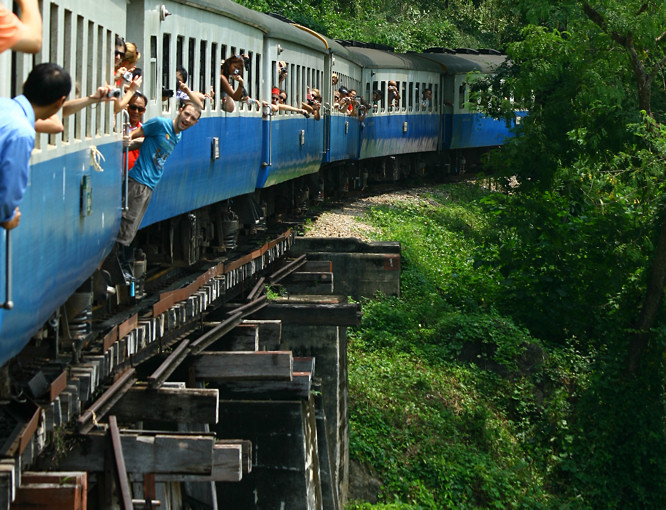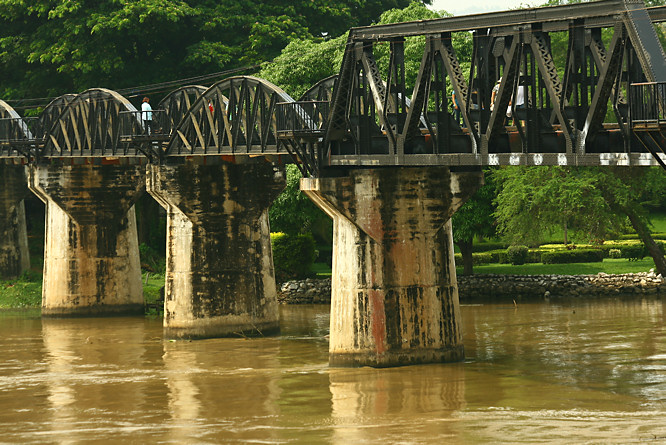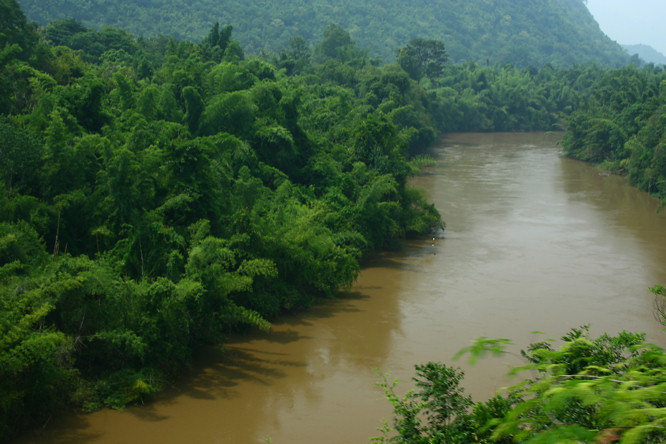Bridge over the River Kwai Bangkok day trip tour
One of the things you have to remember when you go on the Bangkok day trip to the Bridge over the River Kwai is there was not just one bridge. The Japanese slave labour force of comprised of Allied Prisoners of War (POW) were forced to construct the Thailand to Burma railway through thick jungle

Thousands of POW's and forced labourers lost their lives. They built over 40 bridges along the railway route. Prepare yourself for a long coach drive of over two hours. Your destination is to the north of Bangkok. Your driver will stop at a few places on route.
You normally start you trip by visiting the JEATH Kanchanaburi Thailand-Burma railway Museum. JEATH stands for Japan, England, Ameria/Austraila, Thailand, and Holland; the six allied countries whose servicemen were involved with the construction of the 'Death Railway' during World War II. The Japanese were the controllers of the 415km railway project. It sets the scene and tells you the history of what happened in this area of Thailand during WW2.
The railway was a strategic railway built between Thailand and Burma as a way to supply the Japanese army and move troops quickly. The first Japanese engineers survey estimated that it would take at least 5 years to finish the railway line. This would take too long so the Japanese army forced the prisoners of war to complete it in only 16 months. Of the over 230,000 POW's and oppressed labourers thousands died due to disease, starvation, and lack of medical equipment. Many were literally worked to death, thus the name 'Death Railway.'

The history centre is fully air conditioned so you can take your time studying the exhibits in comfort. You will emerge from the museum having a better understanding of the barbaric torture the poor souls went through at the hands of their Japanese captors. Some of the displays are dated and could do with maintenance and modernization.
About 13,000 prisoners of war died and were buried along the length of the railway. I did not realize that local Thai and Burmese workers were also very badly treated and many died. About 80,000 to 100,000 civilians died in the construction of the Thai Burma railway. They were forced labour transported to the construction site from Japanese occupied territory of Malaya, Philippines, Thailand and Burma. Two construction teams, one based in Thailand and the other in Burma worked from opposite ends of the railway line and headed towards the middle.
Many more returned home after the brutal treatment of the Japanese to die of malnutrition, disease as well as suffer other physical and mental conditions.
You can then visit the Commonwealth War Graves cemetery and walk amongst the headstones reading the inscriptions. It is a very emotional sobering experience. Do not be surprised if the experience brings a tear to your eye and a lump to your throat as you consider all those lives wasted. The Commonwealth War Graves Commission employs local Thais to maintain the cemetery to a very high standard. The river, cemetery and surrounds exude an air of tranquillity and peace.

In the academy award winning movie, Bridge Over the River Kwai, the Bridge was actually destroyed the prisoners. In reality it was blown up by the bombs dropped by a B-25 Liberator Bomber, not by the prisoners. The bridge was rebuilt. The only original parts are the side girders.
You can walk over this bridge but it is quite perilous. There is no health and safety regulations enforce. Trains still regularly use this bridge whilst pedestrians are on it. The train does not stop for the pedestrians to get off. There is no separate walk way. You have to climb out onto the girder to get out of the way. You have to have a head for heights. Sometimes there is a Thai musician that plays the theme tune Colonel Bogey to the film on a violin. It is a nice if touristy touch.
You can then go for a journey on the infamous 'Death Railway'. Some groups take the train from the station. The train ride is fun. It has old style hard seats which was okay as the trip is short. The windows are all open. There is no air conditioning apart from what the wind provides. If you are quick, grab a seat on the right hand side as these seats hold the best views. The route goes through dense jungle and cuttings of solid limestone. For a better view some trips leap frog the train and board at a quiet sleep station in the countryside. The train journey from this point is much more enjoyable as travelers are treated to panoramic views along the river. The train will stop on another bridge. This one is wooden, one of the originals. You can get out and explore. Most visitors catch the next train or are picked up by their coach.
Some tours will offer you a trip along the jungle lined river in a long tailed boat to a Mon tribal village. You will glide past waterfalls, caves and huge limestone cliffs. Other tours combine Elephant rides and bamboo Rafting.
Some tourists independently arrange their own trip to the bridge over the river Kwai and go by slow non-air-conditioned train from Thonburi Station in Bangkok. It takes about 3 hours. It is a lot cheaper than the organized coach tours but a bit more uncomfortable. Check the time of the last train back to Bangkok as you do not want to get stranded. If you want to spend more time in the area you can stay at the Jungle Village Resort and proceeded over the next couple of days to do an extensive tour up the river by boat as well walking thru Hellfire Pass.
The prisoners had to cut their way through 'Hellfire Pass.' using only primitive tools. It was solid rock, and monsoonal downpours caused the river to flood. It was slow work. It took a lot of effort for the prisoners to cut their way through the pass. Pressed for time, the Japanese forced them to work in shifts of 18 hours plus with little to eat. Thousand died during the cutting of the rock to construct the Hellfire Pass.
It is a good idea to watch the bridge over the river Kwai film before you go to Thailand so you can fully appreciate what you are seeing. If you do not appreciate the history, the blood, the sweat and toil that went into the construction of the railway all you will be looking at is a bridge in the jungle. If you are taking children or teenagers this is very important. Get them to watch the film. It helps stop the 'Mum Dad I'm board' comments.
The 'Bridge over the River Kwai' film is very loosely based on the building of one of the railway bridges over the Mae Klong river (renamed Khwae Yai in 1960). It is five kilometres from the town of Kanachanaburi at a place called Tha Ma Kham. The film displayed the bad conditions and suffering of the prisoners though the real conditions were much worse. The characters in the film are not real. To add interest for the American film going public the American sailor who escaped was in fact in reality a British Commando Officer. The British POWs did not collaborate with the Japanese. They did everything they could to slow or sabotage work. The film was mainly filmed in Kitulgala in Sri Lanka not Thailand
It is a great day out but a long one. It is about a 10 hour round trip. In a small mini van that is a bit confining. I would recommend trying to get on one of the tours that use large air conditioned coaches not mini-busses. Ask at the hotel when you book the tour. That way you will have enough leg room and be high up so you can really enjoy seeing the Thai country side. Bring some snacks and drinks with you. Check that your tour includes lunch.
Travel books

